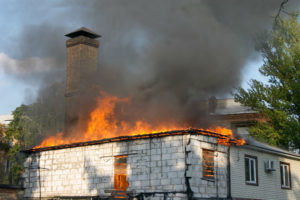 Each time you burn a fire in your fireplace, the smoke that travels up the chimney cools and causes condensation on the walls of your chimney flue. That condensation hardens into creosote. You might be familiar with creosote — it’s what your chimney sweep clears away each year — but you might not know how dangerous creosote is and why its removal is so important.
Each time you burn a fire in your fireplace, the smoke that travels up the chimney cools and causes condensation on the walls of your chimney flue. That condensation hardens into creosote. You might be familiar with creosote — it’s what your chimney sweep clears away each year — but you might not know how dangerous creosote is and why its removal is so important.
Here are the dangers of creosote and why your annual chimney sweeping is so important to your chimney’s, and your home’s, health:
- Creosote is highly flammable. The main reason the National Fire Protection Association recommends an annual chimney sweeping to prevent home fires is because creosote is highly flammable. Even a small buildup of creosote can ignite within your chimney when hit with an errant spark or if the temperature within your chimney rises too high.
- Creosote can block your chimney. If creosote is allowed to build up for too long within your chimney, it can block off your chimney passages. That can prevent fireplace gases, including dangerous carbon monoxide, from exiting through the chimney and force it back into your home’s living spaces.
- Creosote is bad for your health. The creosote that lines your chimney’s flue can flake and fall into the firebox or even create dust within your home. That creosote dust can cause a host of health problems, including skin and eye irritation, respiratory problems and if ingested, it can cause organ damage.
- Creosote can damage your chimney. When creosote sits within your chimney flue for a long period of time, it can cause damage. It can corrode and eat away at your chimney liner, causing damage and weakness that could lead to a house fire down the road.
The best defense against dangerous creosote is to have your chimney swept annually. In between chimney sweepings, there are several things you can do to slow the buildup of creosote within your chimney flue. The goal is to have your fires burning as hotly and efficiently as possible, as a hot fire will deposit less creosote in your chimney. To ensure your fires are burning as they should, there are some best practices you should observe:
- Only burned seasoned firewood. Wood should be thoroughly dried before burning, as wet firewood won’t burn hot. Wet or unseasoned firewood produced a lot of smoke and leads to a more rapid creosote buildup.
- Make sure your damper is fully open. A partially closed damper slows the rise of smoke through your chimney. That allows the smoke to cool and to deposit more condensation in your chimney.
- Leave fireplace doors open. On an open-hearth fireplace, the fireplace doors should be opened fully when a fire is burning. Closed or partially closed fireplace doors impede the chimney’s draft. That prevents enough oxygen from being pulled into the fireplace to allow it to burn efficiently.
To keep your home and your family safe from the dangers of creosote, make sure you have your chimney swept before you burn your first fire of the fall! If you are still in need of your annual chimney sweeping and inspection, call Environmental Chimney Service to schedule an appointment today.
